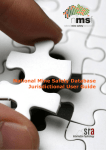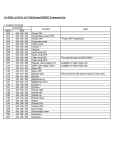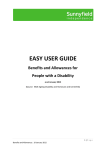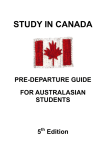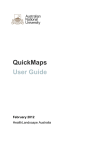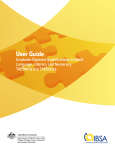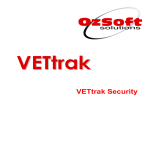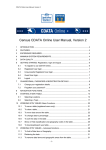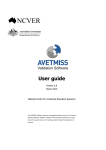Download User's guide to the Standards for VET Accredited Courses
Transcript
User’s guide to the Standards for VET Accredited Courses Table of contents Section 1: About this user’s guide ________________________________________________ 3 Section 2: Regulatory arrangements ______________________________________________ 4 Section 3: Introduction to the Standards for VET Accredited Courses and the Standards for VET Regulators ______________________________________________________ 5 3.1 3.2 3.3 3.4 3.5 3.6 3.7 3.8 3.9 3.10 Section 4: What is accreditation? ___________________________________________ 5 Why develop a course for accreditation? ____________________________ 5 About the Standards for VET Accredited Courses _____________________ 6 About the Standards for VET Regulators ____________________________ 6 Who can submit a course for accreditation? __________________________ 6 Course ownership ______________________________________________ 7 Courses that are accredited by course accrediting bodies _______________ 7 Who can deliver an accredited course? _____________________________ 8 Fees for accreditation ___________________________________________ 8 When can a course be accredited? _________________________________ 8 Stages in accrediting a course __________________________________________ 10 Stage 1: Preliminary research and consultation _____________________________ 11 Stage 2: Course concept proposal________________________________________ 13 Standards for VET Accredited Courses (VAC) ______________________________ 13 Stage 3: Course development ___________________________________________ 15 Stage 4: Course design and preparation of the course accreditation submission ____ 18 4.1 Section A of the course document—copyright and course classification information ___________________________________________________ 19 4.2 Section B of the course document—course information ________________ 21 Vocational or educational outcomes of the course ___________________________ 22 Standards for VET Accredited Courses (VAC) ______________________________ 22 Industry/enterprise/community needs _____________________________________ 23 Review for re-accreditation _____________________________________________ 24 Standards for VET Accredited Courses (VAC) ______________________________ 24 Qualification level _____________________________________________________ 25 Courses that lead to a statement of attainment ______________________________ 26 Employability skills ____________________________________________________ 27 Recognition given to the course by the industry, or any licensing or regulatory requirements _________________________________________________ 28 Course rules and course structure ________________________________________ 29 Entry requirements ____________________________________________________ 30 Assessment strategy and assessor competencies ___________________________ 31 Delivery modes and requirements for on-the-job training ______________________ 32 Specialist facilities and resources required for delivery and assessment of the course33 Pathways and articulation ______________________________________________ 34 Ongoing monitoring and evaluation _______________________________________ 35 4.3 Section C of the course document–units of competency _______________ 36 Stage 5: Assessment of the accreditation submission by the course accrediting body 39 Stage 6: Accreditation _________________________________________________ 39 Section 5: Ongoing monitoring and evaluation ____________________________________ 41 Section 6: Terminology ________________________________________________________ 42 User’s guide to the Standards for VET Accredited Courses Page 2 Section 1: About this user’s guide This guide is for course owners and providers and other stakeholders in the vocational educational and training (VET) sector. It supports the understanding and application of the Standards for VET Accredited Courses, which include the course design standards that must be met for courses accredited and regulated by the Australian Skills Quality Authority (ASQA). The guide also describes ASQA’s role as the national VET regulator in managing course accreditation under Commonwealth legislation, in accordance with the Standards for VET Regulators. Course owners should read both sets of standards prior to developing a course that will be submitted to us for accreditation. The aim of the guide is to help course owners interpret the Standards for VET Accredited Courses and to provide guidance on course development processes. Course owners may also use the guide when conducting course monitoring and evaluation processes to ensure currency and relevancy of courses, and when applying to us to renew the accreditation of courses. Where appropriate, resources that may assist course owners are referenced throughout the guide. ASQA officers may also use this guide to help in applying the standards consistently when carrying out course accreditation functions. User’s guide to the Standards for VET Accredited Courses Page 3 Section 2: Regulatory arrangements ASQA came into operation as the national VET regulator on 1 July 2011, under the National Vocational Education and Training Regulator Act 2011, and associated legislation. One of ASQA’s functions is to accredit courses that may be offered and/or provided by registered training organisations (RTOs). From 1 July 2011, ASQA assumed responsibility for the course accreditation functions previously carried out by the NSW Vocational Education and Training Accreditation Board (VETAB), the ACT Accreditation and Registration Council (ARC) and the NT Department of Education and Training (DET). As each other state refers its powers to the Commonwealth, ASQA will take responsibility for the function of course accreditation in that state. The Victorian Registration and Qualifications Authority (VRQA) and WA Training Accreditation Council (TAC), as non-referring jurisdictions, will retain course accreditation functions within their respective jurisdictions. ASQA can consider applications for accreditation and accredit courses originating from any Australian state or territory. Courses accredited by ASQA, and courses for which ASQA ‘inherits’ regulatory responsibility, are termed ‘VET accredited courses’. ASQA can monitor, amend or cancel (either by application by course owners or on its own initiative) any VET accredited course. In managing course accreditation, ASQA must meet the Standards for VET Regulators and apply the Standards for VET Accredited Courses as prescribed in the National VET Regulator Act 2011. User’s guide to the Standards for VET Accredited Courses Page 4 Section 3: Introduction to the Standards for VET Accredited Courses and the Standards for VET Regulators 3.1 What is accreditation? Accreditation of a course means the formal recognition of a course by: ● ASQA in accordance with the Standards for VET Regulators and the Standards for VET Accredited Courses ● a state/territory course accrediting body in accordance with the AQTF Standards for State and Territory Course Accrediting Bodies and the AQTF Standards for Accredited Courses. Accreditation also means the course is nationally recognised and that an RTO can issue a nationally recognised qualification or statement of attainment following its full or partial completion. Once a course has been accredited, it is listed on the National Register. 3.2 Why develop a course for accreditation? Accredited courses address skill requirements, based on an industry, enterprise, educational, legislative or community need, where the skills are not covered in nationally endorsed training packages. They also have the capacity to address changes in skill requirements in a responsive manner, including changes to the needs of: emerging industries and sectors converging industry sectors, which may reflect considerable overlap of skills between a number of industries or sectors. A collaborative approach between Industry Skills Councils (ISCs), concerned with the development and endorsement of national training packages, and course accrediting bodies, including ASQA, can provide an effective and timely response to rapidly changing needs of industry. In support of a collaborative approach, course accrediting bodies will provide advice, where appropriate, to relevant ISCs and other stakeholders, including identification of gaps in training packages. From an RTO perspective, accreditation means a course may be eligible for: ● listing on the Commonwealth Register of Institutions and Courses for Overseas Students (CRICOS), enabling marketing and delivery to international students ● participant/employer financial assistance through various government programs ● relief from GST on courses. A course may need to be accredited so that participants in the course are eligible for Austudy, Abstudy and other entitlements. In some industries, accreditation of a course may be a requirement for an RTO to obtain insurance for delivery of the course, or for a graduate to obtain an occupational licensing outcome. Accreditation can be an important marketing tool for RTOs as it is evidence of national recognition, enabling portability of qualifications. User’s guide to the Standards for VET Accredited Courses Page 5 3.3 About the Standards for VET Accredited Courses The Standards for VET Accredited Courses apply to the design of VET courses that are submitted to ASQA for accreditation. The Standards also apply to VET accredited courses (regardless of which body originally accredited the course) throughout the period of accreditation. Accreditation of a course is confirmation that the course: ● meets an industry, enterprise, educational, legislative or community need ● identifies appropriate competency outcomes and a satisfactory basis for assessment ● meets national quality assurance requirements ● is aligned appropriately to the Australian Qualifications Framework (AQF) where it leads to a qualification. The accredited course document provides the basis for the development of strategies for training and assessment by each RTO and describes mandatory course rules, entry requirements, outcomes to be achieved, standards for assessment, and required resources. The template for course documentation for accreditation in Appendix 1 to the Standards for VET Accredited Courses describes essential course information and provides the legal specification for the course. ASQA has enhanced this template to provide additional guidance in the documentation of courses for accreditation. The enhanced template is available on the website www.asqa.gov.au. 3.4 About the Standards for VET Regulators The Standards for VET Regulators should be read in conjunction with the Standards for VET Accredited Courses. The standards apply to ASQA under Commonwealth legislation. ASQA will ensure that all applications for course accreditation are assessed for compliance against the Standards for VET Accredited Courses. All course accrediting bodies must require courses to be developed consistent with the policy of the National Quality Council (NQC), as set out in their Training Package Development Handbook. The policy provides advice on how to develop qualifications and units of competency. The Standards for VET Regulators focus on national consistency, client services and responsive management systems. The standards support the national VET system by specifying: ● standards to be met by ASQA in accrediting courses ● quality indicators for assessing ASQA’s performance against the standards ● requirements for undertaking accreditation functions. Accreditation has national effect. Each course accrediting body accepts the accreditation decisions made by any other course accrediting body, including ASQA. This means that once a course is accredited by a course accrediting body and placed on the National Register it is recognised in all other states and territories without the need for further accreditation. 3.5 Who can submit a course for accreditation? There is no requirement to be an RTO in order to make an accreditation submission. Various government departments, industry organisations, enterprises and individuals seek to accredit courses. A course owner may engage a course developer to prepare the accreditation submission under their direction. User’s guide to the Standards for VET Accredited Courses Page 6 A person or organisation from anywhere in Australia can submit a course to ASQA for accreditation. To be accredited, the course must meet the Standards for VET Accredited Courses. A person or organisation from a state or territory that has referred its VET regulatory powers to the Commonwealth may submit a course to the accrediting body of a state that has not yet referred its powers or will not be referring its powers. However, the standards that these accrediting bodies must apply allow for the bodies to determine that a course may be more appropriately assessed by another course accrediting body, including ASQA. Applications to amend an accredited course or to cancel the accreditation of a course, if the course was accredited by a state that has not yet referred its powers or will not be referring its powers, must be made to the course accrediting body that accredited the course. An application to renew the accreditation of such a course may be made to ASQA. Applications to amend an accredited course or to cancel or renew the accreditation of a course, if the course is a VET accredited course (that is, the course was accredited by ASQA or by a state/territory that has referred its powers to the Commonwealth) must be made to ASQA. 3.6 Course ownership Courses may be either owned by the Crown or privately owned. Crown-owned courses are developed with public funds and are available in the public domain. Privately owned courses are developed with private funds and are available only from the course owner. Privately owned courses may have been developed by private RTOs for their own delivery. The owner has the discretion to make them available, or not, and to impose any fees or conditions for access. Organisations or individuals that are not RTOs may also own courses. However, a course owner who is not an RTO, and does not intend to become an RTO, will need to develop an agreement with an RTO for the delivery of the course under the conditions they have determined. This is in accordance with the standards applying to registered training oragnisations, which determine that only RTOs can deliver and/or assess nationally recognised qualifications and issue AQF qualifications or statements of attainment. 3.7 Courses that are accredited by course accrediting bodies Courses that are accredited by course accrediting bodies provide the following qualifications under the AQF: ● Vocational Graduate Diploma ● Vocational Graduate Certificate ● Advanced Diploma ● Diploma ● Certificate IV ● Certificate III ● Certificate II ● Certificate I A course that does not lead to a qualification under the AQF can also be accredited by a course accrediting body. The course title in this case reads ‘Course in ….’ Such courses do not have the breadth and depth of knowledge required for a qualification but they can lead to the issuance of an AQF statement of attainment that is nationally recognised. User’s guide to the Standards for VET Accredited Courses Page 7 3.8 Who can deliver an accredited course? Only an RTO can deliver and/or assess an accredited course and issue a qualification or statement of attainment under the AQF, and it can do so only if the course is listed in its scope of registration. 3.9 Fees for accreditation Fees and charges can be applied to applications associated with the accreditation of courses, including: ● initial accreditation of a course ● renewal of accreditation of a course ● amendment to an accredited course. ● cancellation of the accreditation of a course. The schedule of fees and charges is available on the website www.asqa.gov.au. There is no fee for the submission and evaluation of a course concept proposal. 3.10 When can a course be accredited? A course can be accredited if it meets the design requirements of the accredited course standards, including that: ● there is clear evidence that the course meets an identified industry, enterprise, educational, legislative or community need ● the course is consistent with the AQF in relation to qualifications or courses leading to a statement of attainment ● the course does not duplicate by title or coverage the outcomes of an endorsed training package qualification ● the course is based on nationally endorsed units of competency, where these are available, or, where these are not available, on units of competency developed as part of the course, or on modules ● units of competency are developed in consultation with, and validated by, appropriate industry, enterprise, community and/or professional groups and documented in accordance with nationally agreed specifications consistent with the requirements of the Training Package Development Handbook. Modules may be included where the course owner can establish, prior to development and to ASQA’s satisfaction, that it is not possible to develop appropriate units of competency. A course may be accredited if, for example, it: ● combines units of competency from two or more training packages to meet a particular work function or role not accommodated by a single training package ● combines units of competency from a training package with units of competency that require development to reflect industry, enterprise or community needs to address gaps in training packages ● combines units of competency from one training package with different packaging rules to meet a particular work function or role not accommodated within the training package ● develops units of competency for niche areas of industry, enterprise or community needs, where there is no training package coverage ● combines enterprise or community units of competency and units of competency from one or more training packages. A course will not be accredited if it: User’s guide to the Standards for VET Accredited Courses Page 8 ● duplicates, by title or coverage, the outcomes of an endorsed training package qualification ● offers outcomes that can be achieved through the packaging rules applicable to a training package qualification ● offers outcomes that can be met by contextualising units of competency within a training package qualification ● is a sub-set of a single training package qualification that could be recognised through one or more statements of attainment or a skill set ● includes units of competency additional to those in a training package qualification that could be recognised through statements of attainment in addition to the AQF qualification ● is made up of modules that duplicate the units of competency of a training package qualification. Resources ● Standards for VET Accredited Courses—www.asqa.gov.au ● Standards for VET Regulators—www.asqa.gov.au ● Australian Qualifications Framework 2011—www.aqf.edu.au User’s guide to the Standards for VET Accredited Courses Page 9 Section 4: Stages in accrediting a course There are six stages to accrediting a course: Stage 1—Preliminary research and consultation Stage 2—Course concept proposal Stage 3—Course development Stage 4—Course design and preparation of the course accreditation submission Stage 5—Assessment of the accreditation submission by the course accrediting body Stage 6—Accreditation This section outlines the intent of each stage of accreditation, together with references to the relevant standard in the Standards for VET Accredited Courses and the Standards for VET Regulators. At the end of each stage, references to useful resources are included where appropriate. User’s guide to the Standards for VET Accredited Courses Page 10 Stage 1: Preliminary research and consultation Intent The aim during this stage is to: ● establish the need for the course ● engage those stakeholders with an interest in the course ● ensure the intended course will not duplicate the title or coverage of a training package qualification. Standards for VET Accredited Courses (VAC) VAC 6 – Duplication 6.1 Applications for course accreditation will not be accredited if the course duplicates, by title or coverage, the outcomes of an endorsed training package qualification. VAC 7—Course design standard 7.1 VET accredited courses are based on an established industry, enterprise, education, legislative or community need. 7.2 VET accredited courses are based on nationally endorsed units of competency where these are available and where these are not available the course is based on: (a) units of competency developed as part of the course; or (b) modules. These units of competency or modules are developed in consultation with, and validated by, appropriate industry, enterprise, community and/or professional groups and documented in accordance with nationally agreed specifications, consistent with the requirements of the Training Package Development Handbook. Consultation with Industry Skills Council must take place to ensure that the course does not duplicate, by title or coverage, the outcomes of an endorsed Training Package qualification. (Note: Modules may be included where the person in respect of whom the course is accredited can establish to the satisfaction of the National VET Regulator, prior to development, that it is not possible to develop appropriate competency standards.) 7.5 VET accredited courses confirm recognition to be given to the course by licensing, regulatory, professional or industry bodies where applicable. Explanatory notes The extent of research and consultation will be guided by the intended scope of the course, its content and complexity, and the number of stakeholders who may need to be involved in its development and implementation. Preliminary research provides a general overview of the proposed course. It establishes the industry, industry sector, enterprise and/or community need for a new course by: ● identifying the intended outcomes of the proposed course in broad terms by determining: ○ what industry and/or community sector or cross-industry functions it will cover ○ the size, diversity and complexity of the industry or community ○ the geographical dispersion of the industry or community ○ the scope and breadth of the course User’s guide to the Standards for VET Accredited Courses Page 11 ○ ● the competencies needed by the industry, industry sector or community in broad terms - any statutory, licensing or regulatory requirements - the future requirements of industry, industry sector, enterprise and/or the community, i.e., anticipating future directions, including changes in technology and skill requirements, and undertaking relevant market research to establish the feasibility of the course, including: o the possible extent of market demand for the proposed course o the potential size of the employment market for graduates of the intended course establishing if units of competency already exist through an information search, considering: ○ the currency, quality, suitability, useability and status of existing training package qualifications ○ copyright issues. Organisations that may be key stakeholders in the course development and may be involved in the consultation process include: ● industry, enterprise and/or community groups ● Industry Skills Councils ● employee organisations ● employer organisations ● professional associations ● regulatory and/or licensing bodies. The flexibility provided by the packaging rules applying to training package qualifications must be explored before developing a new course. For example, units of competency from other training packages may be identified for use as electives for an appropriate training package qualification. Additional flexibility is available through the contextualising of units of competency within training package qualifications to meet the specific training needs of client groups without requiring a new course to be developed for accreditation. If an existing training package qualification meets the identified training need, a course that duplicates the outcome will not be accredited. Consultation must be ongoing throughout the development and design of an accredited course. The focus of further consultation to engage industry and other stakeholders in development is outlined in stage 3 (course development). Resources ● National Register of nationally endorsed training package qualifications, units of competency and accredited courses—www.training.gov.au ● National Industry Skills Councils—www.isc.org.au ● State or national regulatory and/or licensing bodies applicable to the industry ● Standards for VET Regulators: Standards 1 and 2 and the requirements for undertaking course accreditation—www.asqa.qov.au User’s guide to the Standards for VET Accredited Courses Page 12 Stage 2: Course concept proposal Intent The aim during this stage is to ensure that before detailed course development commences the accrediting body confirms that the course is eligible for accreditation. Standards for VET Accredited Courses (VAC) VAC 7—Course design standard 7.1 VET accredited courses are based on an established industry, enterprise, education, legislative or community need. 7.2 VET accredited courses are based on nationally endorsed units of competency where these are available and where these are not available the course is based on: (a) units of competency developed as part of the course; or (b) modules. These units of competency or modules are developed in consultation with, and validated by, appropriate industry, enterprise, community and/or professional groups and documented in accordance with nationally agreed specifications, consistent with the requirements of the Training Package Development Handbook. Consultation with Industry Skills Council must take place to ensure that the course does not duplicate, by title or coverage, the outcomes of an endorsed Training Package qualification. (Note: Modules may be included where the person in respect of whom the course is accredited can establish to the satisfaction of the National VET Regulator, prior to development, that it is not possible to develop appropriate competency standards.) 7.5 VET accredited courses confirm recognition to be given to the course by licensing, regulatory, professional or industry bodies where applicable. Explanatory notes Stage 2 is the ‘course concept proposal’ stage. Preparation of the concept proposal and its evaluation by ASQA is an important quality assurance mechanism. It is intended to ensure that developers do not go through the entire process of development only to find that the course cannot be accredited. A written course concept proposal is to be submitted to ASQA for evaluation. An application for accreditation must be accompanied by written notification from ASQA (dated within 12 months of the date of submission of the application) that the proposal has been ‘noted’. In general terms, the course concept proposal asks for confirmation that: ● there has been consultation with industry, community and other key stakeholder groups ● there is support for the course concept ● the vocational, industry, educational or community need for the course can be identified in broad terms ● nationally endorsed training package qualifications, units of competency and accredited courses have been searched to ensure there will be no duplication of qualifications or units of competency that already exist ● the major stakeholders who will advise on the development of the course have been identified. Note: Where the intended course outcomes fall within an Industry Skills Council’s area of industry coverage, the relevant council is to be consulted. If the course is proposing to deliver an industry regulatory or licensed outcome, the industry regulatory and/or licensing bodies is to be consulted. User’s guide to the Standards for VET Accredited Courses Page 13 If the course proposal is for a knowledge-based course that does not have intended vocational outcomes, and the course owner believes it will not be possible to write the course or part thereof in a competency-based format, then, prior to development, permission must be sought from ASQA to develop modules for inclusion in the course. Justification for the request must be provided as part of the course concept proposal process. Granting permission for the development of modules is at ASQA’s sole discretion. Courses may consist of a combination of modules and units of competency. If the course is considered to be potentially high-risk, the course owner may be asked to provide additional information in relation to the intended course and indicate how the risks will be managed. There is considered to be potential high risk if, for example, the course leads to licensing outcomes, is related to public safety issues, is intended to respond to specific legislative requirements, or is to be delivered to overseas students in Australia or offshore. The Training Package Development Handbook provides useful information about research and consultation to determine, for example, the level of industry acceptance and whether units of competency and qualifications meet current and anticipated future industry needs. Some of this information may be useful for the preliminary research required for development of a concept proposal for an accredited course. Resources National Register of nationally endorsed training package qualifications, units of competency and accredited courses—www.training.gov.au National Industry Skills Councils—www.isc.org.au State or national regulatory and/or licensing bodies applicable to the industry Standards for VET Regulators: Standards 1 and 2 and the requirements for undertaking course accreditation—www.asqa.qov.au User’s guide to the Standards for VET Accredited Courses Page 14 Stage 3: Course development Intent The aim during this stage is to: ● ensure industry and other relevant stakeholders are fully engaged in the development and design of the course and that consultation with industry is ongoing through the development stage ● validate the intended skills and knowledge outcomes of the course. Standards for VET Accredited Courses (VAC) VAC 7—Course design standard 7.1 VET accredited courses are based on an established industry, enterprise, education, legislative or community need. 7.2 VET accredited courses are based on nationally endorsed units of competency where these are available and where these are not available the course is based on: (a) units of competency developed as part of the course; or (b) modules. These units of competency or modules are developed in consultation with, and validated by, appropriate industry, enterprise, community and/or professional groups and documented in accordance with nationally agreed specifications, consistent with the requirements of the Training Package Development Handbook. Consultation with Industry Skills Council must take place to ensure that the course does not duplicate, by title or coverage, the outcomes of an endorsed Training Package qualification. (Note: Modules may be included where the person in respect of whom the course is accredited can establish to the satisfaction of the National VET Regulator, prior to development, that it is not possible to develop appropriate competency standards.) 7.3 VET accredited courses either: (a) lead to a VET qualification and have course outcomes that are consistent with the Australian Qualifications Framework qualification descriptor identified for the course, or (b) lead only to a VET statement of attainment when course outcomes meet an identified industry/enterprise/community need but do not have the breadth and depth required for a VET qualification as stated in the guidelines for qualifications in the Australian Qualifications Framework. The course title will read ‘Course in ...’. 7.5 VET accredited courses confirm recognition to be given to the course by licensing, regulatory, professional or industry bodies where applicable. Explanatory notes The consultation that occurred in stages 1 and 2 aimed to identify key stakeholder support for the course concept and to scope the extent of the industry, community or educational need, and may have been required to obtain approval to commence development of the course. Consultation during this stage seeks to identify the details of the course, including the intended skills and knowledge outcomes, and the training and assessment structures and pathways to ensure the course: ● accurately reflects the market segmentations of potential employers and learners ● is related to realistic industry and workplace needs or community needs User’s guide to the Standards for VET Accredited Courses Page 15 ● provides the skills and knowledge outcomes required by the industry or community ● reflects current and future skill requirements in the industry or the community ● will meet the needs of learners most likely to enrol in the course ● provides the most flexible course structure to meet both industry and learner needs ● enables the recognition of course units of competency or other learning outcomes. The level of consultation and research required for a course will depend on the size, complexity and required course outcomes. For example, a course designed to be delivered for a particular enterprise and a very specific target group is likely to require significantly less consultation than one intended for national delivery. Clear identification of the required skills and knowledge outcomes during the research stage will provide clarity of focus on course objectives during development and is equally as critical for community courses as it is for vocational courses. Development of the intended skills and knowledge profile will also assist in aligning the course to the appropriate AQF descriptor at a later stage of the design of the course. The skills and knowledge profile is often identified through a job function analysis for both vocational and community courses, while a knowledge profile may appropriately be developed for a knowledgebased course. This will provide the basis for the design of the course and for competency development, and the most practical and cost-effective methodology should be used. Development of units of competency must be undertaken in close consultation with technical experts and practitioners. Expertise in unit of competency development and course design is critical in achieving a quality outcome. The intended skill and knowledge outcomes of the course can be identified through consideration of: ● relevant industry or educational standards ● any current available research e.g., occupational analyses, skills audits, data on emerging technology and industry trends ● manuals, operating procedures and textbooks ● position descriptions and role statements ● job advertisements. They can also be identified through the use of techniques such as: ● surveys ● interviews ● group processes ● job and functional analysis ● observation or other techniques. These investigations should build on preliminary research, as outlined in stages 1 and 2, to confirm details of the target group, including the demographics (gender, age, cultural background, language and education levels) of likely participants. Knowing target group characteristics will assist in determining the most appropriate mode of delivery in stage 4 (course design). If seeking to renew the accreditation of a course If an existing course is being reviewed to make application to renew accreditation, then, wherever possible, graduates, clients, learners and/or employers of graduates should be included in the consultation process for evaluating the existing course and identifying any need for change. Data available from the monitoring and maintenance of the existing course (see section 5) will also provide valuable information when designing a course for rerenewal of accreditation. User’s guide to the Standards for VET Accredited Courses Page 16 Resources ● Training Package Development Handbook: Training package guidelines (6. Development and endorsement processes)— http://www.deewr.gov.au/skills/overview/policy/tpdh/pages/main.aspx ● Standards for VET Regulators: Standards 1 and 2 and the requirements for undertaking course accreditation—www.asqa.qov.au User’s guide to the Standards for VET Accredited Courses Page 17 Stage 4: Course design and preparation of the course accreditation submission Intent The aim during this stage is to design the course and prepare the documentation for the course accreditation submission in the required template. This provides the basis for the development of training and assessment strategies by the RTO and demonstrates how the course complies with the Standards for VET Accredited Courses. Explanatory notes At the beginning of the design stage, the course developer should download the template for course documentation for accreditation (the course document). The template is Appendix 1 to the Standards for VET Accredited Courses. ASQA has developed an enhanced version, providing additional guidance, that can be downloaded from www.asqa.gov.au. The template specifies the information to be provided for accreditation or re-accreditation of a course, and acts as a helpful focus during the design stage. The course document is the legally recognised specification for the course. It provides the basis for the development of strategies for training and assessment by each RTO and describes essential course information. It is divided into three sections: ● Section A: Copyright and course classification information—provides information about copyright, course classification and type of application, i.e., accreditation or re-accreditation. ● Section B: Course information—provides details of industry need, course structure, and the rules under which the course may be accessed, delivered and assessed, and monitored. ● Section C: Units of competency—includes the industry, enterprise or community units of competency or modules that are contained in the course. The following section guides the user through the course document. The relevant standards from both the Standards for VET Accredited Courses and the Standards for VET Regulators are referenced, as appropriate, to each part of the template. Relevant resources are also identified. User’s guide to the Standards for VET Accredited Courses Page 18 Section A of the course document—copyright and course classification information Copyright owner of the course Identify the name of the legal entity or individual who owns copyright of the course(s) being submitted for accreditation. This should include both the ongoing organisational contact details and the day-today contact details where these are different. Address Provide the street, postal address and email address of the legal entity or individual that is the course owner. Type of submission The submission should be identified as being for ‘accreditation’ or ‘renewal of accreditation’ of a course. Copyright acknowledgement Provide evidence of appropriate copyright approval in relation to units of competency or modules not owned by the copyright owner of the course. If a Crown-copyright accredited course is being developed, contact should be made with AEShareNET for further information on the ‘Free for Education licence’ requirements. Commonwealth-owned materials such as training packages are also licensed under the ‘Free for Education licence’. For units of competency imported from training packages, the following sample text may be used: The following unit(s) of competency: [list these by code and title] are from the [code] [title] training package administered by the Commonwealth of Australia © Commonwealth of Australia. Copyright of units of competency or modules that the course has imported from other accredited courses must be identified. Licensing and franchise Indicate whether the course(s) may be used under license or franchise and, if relevant, the requirements for use by other providers. The contact details for these arrangements should be given. User’s guide to the Standards for VET Accredited Courses Page 19 Course accrediting body Identify that ASQA is the course accreditation body to which the accreditation document is being submitted. AVETMISS information The Australian Vocational Education and Training Management Information Statistical Standard (AVETMISS) provides a national framework for the collection and dissemination of VET information, necessary for the consistent and accurate measurement of VET delivery in Australia. AVETMISS data provided in course accreditation submissions contributes to planning in the national VET system. Using Australian and New Zealand Standard Classification of Occupations (ANZSCO) codes, identify the appropriate industry occupational group and field of education for which the course is intended. This will assist in identifying stakeholders who must be consulted in the development of the course. It will also keep the design stage focused on the intended course outcomes; that is, considering for whom the course is being designed Period of accreditation Include details of the requested period of accreditation. If the course is accredited, ASQA will confirm accreditation dates. A course may be accredited for up to five years. Resources ● Data elements and classification codes for AVETMISS data—www.ncver.edu.au ● Standards for VET Regulators: Standards 1 and 2 and the requirements for undertaking course accreditation—www.asqa.qov.au ● Information on the ‘Free for Education licence’—www.aesharenet.com.au User’s guide to the Standards for VET Accredited Courses Page 20 Section B of the course document—course information Nomenclature (See part 1 of section B of the course document.) The course document is to include the name of the qualification, or the title ‘Course in …’, that will be awarded on completion of the course. The course must be named in accordance with the AQF titling protocol. The AQF Implementation Handbook provides details on how to determine the course title and the Training Package Development Handbook contains advice about conventions on codes and titles. The course must not have the same name as an existing endorsed training package qualification. Resources ● AQF Implementation Handbook—www.aqf.edu.au ● Training Package Development Handbook: Coding and titling of units of competency; Coding and titling of training packages; Coding and titling for qualifications—www.deewr.gov.au ● Standards for VET Regulators: Standard 1 and the requirements for undertaking course accreditation—www.asqa.qov.au ● Information on the ‘Free for Education licence’—www.aesharenet.com.au User’s guide to the Standards for VET Accredited Courses Page 21 Vocational or educational outcomes of the course (See part 2 of section B of the course document.) Standards for VET Accredited Courses (VAC) VAC 7—Course design standard 7.1 VET accredited courses are based on an established industry, enterprise, education, legislative or community need. 7.3 VET accredited courses either: (a) lead to a VET qualification and have course outcomes that are consistent with the Australian Qualifications Framework qualification descriptor identified for the course, or (b) lead only to a VET statement of attainment when course outcomes meet an identified industry/enterprise/community need but do not have the breadth and depth required for a VET qualification as stated in the guidelines for qualifications in the Australian Qualifications Framework. The course title will read ‘Course in ...’. 7.7 VET accredited courses identify exit points from the course which provide for vocational or educational outcomes where applicable. Explanatory notes Course developers are required to state the intended purpose of the course, which would have been identified through the scoping exercise undertaken at stage 1 (preliminary research and consultation) and stage 3 (course development). Where more than one course is included in the accreditation submission, course developers will need to identify the anticipated vocational, community, occupational or general educational outcomes for each course. Resources ● Standards for VET Regulators: Requirements for undertaking course accreditation— www.asqa.qov.au ● Information on the 'Free for Education licence'—www.aesharenet.com.au User’s guide to the Standards for VET Accredited Courses Page 22 Industry/enterprise/community needs (See part 3.1 of section B of the course document.) Standards for VET Accredited Courses (VAC) VAC 7—Course design standard 7.1 VET accredited courses are based on an established industry, enterprise, education, legislative or community need. 7.5 VET accredited courses confirm recognition to be given to the course by licensing, regulatory, professional or industry bodies where applicable. Explanatory notes During stage 2, information was required to confirm industry and/or community support for the course concept. In the accreditation submission, support for the course as it has been developed must also be confirmed. Documentary evidence is to be provided that consultation has taken place with industry and/or community stakeholders in the development and validation of the skills and knowledge outcomes of the course, the course structure, and the assessment strategy. Resources ● Training Package Development Handbook: Training package guidelines (6. Development and endorsement processes)—www.deewr.gov.au ● Standards for VET Regulators: Requirements for undertaking course accreditation— www.asqa.qov.au User’s guide to the Standards for VET Accredited Courses Page 23 Review for renewal ofaccreditation (See part 3.2 of section B of the course document.) Standards for VET Accredited Courses (VAC) VAC 7—Course design standard 7.1VET accredited courses are based on an established industry, enterprise, education, legislative or community need. 7.13VET accredited courses identify course monitoring and evaluation processes which will ensure that the course content and outcomes are reviewed and remain current and relevant throughout the period of accreditation. Explanatory notes If applying to renew accreditation, early consultation should occur with the original accrediting body about the re-accreditation processes and requirements, and any fees that might apply. A course must be reviewed and evaluated before a submission is made for renewal of accreditation. If a course substantially changes as a result of the review, it will be necessary to provide details of transition arrangements as part of the submission for renewal of accreditation. The accreditation of a course will not be renewed if a training package unit, qualification or skill set that covers the course outcomes has been developed. The application for re-accreditation must demonstrate that the accredited course continues to meet the current needs of industry, enterprise and/or community groups. The submission for re-accreditation must provide details about how monitoring and evaluation have been taken into account, such as feedback from industry, graduates or employers of graduates. Resources ● Training Package Development Handbook: Training package guidelines (6. Development and endorsement processes)—www.deewr.gov.au ● Standards for VET Regulators: Requirements for undertaking course accreditation— www.asqa.qov.au User’s guide to the Standards for VET Accredited Courses Page 24 Qualification level (See part 4.1 of section B of the course document.) Standards for VET Accredited Courses (VAC) VAC 7—Course design standard 7.1 VET accredited courses are based on an established industry, enterprise, education, legislative or community need. 7.3 VET accredited courses either: (a) lead to a VET qualification and have course outcomes that are consistent with the Australian Qualifications Framework qualification descriptor identified for the course, or (b) lead only to a VET statement of attainment when course outcomes meet an identified industry/enterprise/community need but do not have the breadth and depth required for a VET qualification as stated in the guidelines for qualifications in the Australian Qualifications Framework. The course title will read 'Course in ...'. Explanatory notes The AQF level selected as being appropriate for the course will reflect what is expected of the participant in applying the skills and knowledge they have learned. This is determined by the application of the defined skills and knowledge to the standards expected in the relevant workplace requirements or other vocational outcome. Alignment to the AQF occurs when a group of units of competency are packaged into a viable AQF qualification or qualifications. Note that individual units of competency are not aligned to the AQF. A course developer must: ● determine the AQF qualification by assessing the course outcomes against the distinguishing features and characteristics of the AQF qualifications ● allocate a course a title in accordance with the AQF titling protocol (as outlined in the advice about nomenclature earlier in this section). The AQF Implementation Handbook provides details on how to determine and title a qualification. By referring to the job role or the skills and knowledge profile developed for the course, course developers will be able to determine the AQF level for validation by industry or community stakeholders. The course must not duplicate the outcomes of a training package unit of competency, skill set or qualification. User’s guide to the Standards for VET Accredited Courses Page 25 Courses that lead to a statement of attainment Explanatory notes A course may meet an identified industry, enterprise or community need but may not have the breadth and depth required for a qualification. Such a course will lead to a statement of attainment. Courses that lead to a statement of attainment rather than a qualification must comply with the Standards for VET Accredited Courses. The AQF titling protocol is used for a course that results in a statement of attainment, with the exception that the course title will be ‘Course in …’ Courses titled ‘Course in …’ are award courses and the issuance of a statement of attainment is based on the formal assessment of participants as specified in the accreditation submission. A unit of competency is the smallest subset of a training package qualification, a state accredited qualification, or a ‘Course in …’, that can be nationally recognised, resulting in the issue of a statement of attainment. Resources ● Australian Qualifications Framework 2011—www.aqf.edu.au ● Training Package Development Handbook: Australian Qualifications Framework Alignment— www.deewr.gov.au ● Standards for VET Regulators: Standard 1 and the requirements for undertaking course accreditation—www.asqa.qov.au User’s guide to the Standards for VET Accredited Courses Page 26 Employability skills (See part 4.2 of section B of the course document.) Standards for VET Accredited Courses (VAC) VAC 7—Course design standard 7.4 VET accredited courses identify employability skills relevant to the course outcomes. Explanatory notes Employability skills are generic skills that are required in all work situations. Employability skills are to be embedded within units of competency. For each qualification, an employability skills summary must be prepared. Advice on how to prepare the employability skills summary is detailed in the Training Package Development Handbook. The employability skills are: ● communication ● teamwork ● problem solving ● initiative and enterprise ● planning and organising ● self management ● learning ● technology. An employability skills summary is optional for a course with the title ‘Course in ...’. Resources ● Australian Qualifications Framework 2011—www.aqf.edu.au ● Training Package Development Handbook: Qualifications Framework Policy (Employability skills summaries); Qualifications Framework Guidelines (7. Employability skills summaries); Unit of Competency Policy (Employability skills); Unit of Competency Guidelines (7. Employability skills)—www.deewr.gov.au ● Standards for VET Regulators: Standard 1 and the requirements for undertaking course accreditation—www.asqa.qov.au User’s guide to the Standards for VET Accredited Courses Page 27 Recognition given to the course by the industry, or any licensing or regulatory requirements (See parts 4.3 and 4.4 of section B of the course document.) Standards for VET Accredited Courses (VAC) VAC 7—Course design standard 7.5 VET accredited courses confirm recognition to be given to the course by licensing, regulatory, professional or industry bodies where applicable. Explanatory notes Where a course is recognised by professional or industry bodies or regulatory/licensing authorities, this is to be identified. For example, completion of the course may result in membership of a professional body being granted, or a licensing outcome may be achieved. There must be consultation with professional or industry bodies and licensing/regulatory bodies relevant to the proposed course. Resources ● Standards for VET Regulators: Standard 2—www.asqa.qov.au User’s guide to the Standards for VET Accredited Courses Page 28 Course rules and course structure (See parts 5 and 5.1 of section B of the course document.) Standards for VET Accredited Courses (VAC) VAC 7—Course design standard 7.6 VET accredited courses specify the rules for the structure of the course. 7.7 VET accredited courses identify exit points from the course which provide for vocational or education outcomes where applicable. Explanatory notes The course structure will be guided by stakeholder and client advice. The rules for completion of the course will reflect the skills and knowledge outcomes identified for the course and the pathways that learners may use to achieve those outcomes. Units of competency must be grouped and packaged into meaningful combinations that reflect the roles and skill outcomes identified by the industry/enterprise/community/professional or regulatory body. The course structure may take a variety of forms, including: ● core only ● core and electives ● core and specialisation(s) ● core, specialisation(s) and electives ● electives only. Further information about these packaging models is available in the Training Package Development Handbook. Early exit points must be identified where there is a vocational or general education outcome. Resources ● Training Package Development Handbook: Qualifications Framework Policy (Packaging flexibility); Qualifications Framework Guidelines (11. Packaging models)—www.deewr.gov.au ● Standards for VET Regulators: Standard 1 and the requirements for undertaking course accreditation—www.asqa.qov.au User’s guide to the Standards for VET Accredited Courses Page 29 Entry requirements (See part 5.2 of section B of the course document) Standards for VET Accredited Courses (VAC) VAC 7—Course design standard 7.9 VET accredited courses specify any entry requirements to the course and justify any explicit limitations to access. Explanatory notes Entry requirements do not form part of the qualification, but are specific to the knowledge, skills or experience required to enter and successfully undertake an education or training program. They should be expressed in terms of competency, units of competency or their equivalent, and may include licensing or industry recognised standards. Not all courses will have entry requirements and any limitations to entry must be justified. A course may not contain any explicit limitations to access and delivery pathways based on age, gender, employment, social or educational background. Entry requirements should be developed in consultation with industry or community stakeholders as appropriate. The accreditation submission may also make recommendations regarding competencies that will assist participants in achieving the intended course outcomes, for example: ● specifying the level of language, mathematical or other skills that are required by the course ● the AQF Implementation Handbook provides advice for Vocational Graduate Certificates and Vocational Graduate Diplomas that ‘candidates may enter the qualification through a number of entry points demonstrating potential to undertake study at graduate level …’. Resources ● AQF Implementation Handbook—www.aqf.edu.au ● Training Package Development Handbook: Qualifications Framework Policy (Entry requirements); Qualifications Framework Guidelines (1. Advice on training package pathways); Training Package Policy (Access and equity)—www.deewr.gov.au ● Standards for VET Regulators: Standard 1 and the requirements for undertaking course accreditation—www.asqa.qov.au User’s guide to the Standards for VET Accredited Courses Page 30 Assessment strategy and assessor competencies (See parts 6.1 and 6.2 of section B of the course document) Standards for VET Accredited Courses (VAC) VAC 7—Course design standard 7.10 VET accredited courses specify course assessment strategies, which: (a) are valid, reliable, flexible and fair (b) support the collection of evidence that is sufficient, valid, authentic and current (c) are consistent with the assessment requirements in the relevant training package(s) where nationally endorsed units of competency are used (d) ensure that workplace and regulatory requirements, where relevant, are met; and (e) identify and justify any requirement for workplace and/or simulated assessment. 7.12 VET accredited courses specify specialist facilities and resources and the vocational competency requirements of trainers and assessors essential for the delivery of the course. Explanatory notes The assessment strategy should accurately reflect the characteristics and learning outcomes appropriate for the AQF level of the qualification. The assessor competencies must be clearly stated and in accordance with the requirements of the relevant standards for RTOs. Resources ● Training Package Development Handbook: Assessment guidelines policy and guidelines— www.deewr.gov.au ● AQTF Essential Conditions and Standards for Continuing Registration: Standard 1— www.training.com.au ● Users’ Guide to the AQTF Essential Conditions and Standards for Continuing Registration— www.training.com.au ● Standards for NVR Registered Training Organisations—www.asqa.gov.au ● Standards for VET Regulators: Standards 1 and 2 and the requirements for undertaking course accreditation—www.asqa.qov.au User’s guide to the Standards for VET Accredited Courses Page 31 Delivery modes and requirements for on-the-job training (See part 7.1 of section B of the course document) Standards for VET Accredited Courses (VAC) VAC 7—Course design standard 7.11 VET accredited courses provide guidance on appropriate delivery modes, together with advice on limitations on course delivery modes and any requirements for on-the-job training. Explanatory notes In some circumstances, specific modes of delivery may be essential to enable the course outcomes to be achieved. If this is the case, the modes must be stated and justified when the course is submitted for accreditation. If any modes of delivery are identified as inappropriate by industry/community stakeholders, this is to be justified in the submission. For example, industry stakeholders may determine that assessment of a particular competency cannot be undertaken in a simulated environment. This must be evidenced by providing relevant feedback from industry/enterprise/community or regulatory stakeholders. Advice on delivery modes should reflect the characteristics of the target group(s) and allow for flexibility. Resources ● Training Package Development Handbook: Training Package Policy (Access and equity)— www.deewr.gov.au ● Standards for VET Regulators: Standard 1 and the requirements for undertaking course accreditation—http://www.asqa.qov.au User’s guide to the Standards for VET Accredited Courses Page 32 Specialist facilities and resources required for delivery and assessment of the course (See part 7.2 of section B of the course document) Standards for VET Accredited Courses (VAC) VAC 7—Course design standard 7.10 VET accredited courses specify course assessment strategies, which: (a) are valid, reliable, flexible and fair (b) support the collection of evidence that is sufficient, valid, authentic and current (c) are consistent with the assessment requirements in the relevant training package(s) where nationally endorsed units of competency are used (d) ensure that workplace and regulatory requirements, where relevant, are met, and (e) identify and justify any requirement for workplace and/or simulated assessment. 7.12 VET accredited courses specify specialist facilities and resources and the vocational competency requirements of trainers and assessors essential for the delivery of the course. Explanatory notes Any specialist facilities and resources required for delivery and assessment of the course should be identified. The standards for RTOs require that the utilisation of staff, facilities, equipment, and training and assessment materials is consistent with the requirements of the accredited course or in the relevant training package. Clearly identifying this information in the course documentation is an important way in which the copyright owner can assure the quality of course delivery and assessment. Resources ● AQTF Essential Conditions and Standards for Continuing Registration: Standard 1 – www.training.com.au ● Users’ Guide to the AQTF Essential Conditions and Standards for Continuing Registration – www.training.com.au ● Standards for NVR Registered Training Organisations—www.asqa.gov.au ● Standards for VET Regulators: Standard 1 and the requirements for undertaking course accreditation—www.asqa.qov.au. User’s guide to the Standards for VET Accredited Courses Page 33 Pathways and articulation (See part 8 of section B of the course document) Standards for VET Accredited Courses (VAC) VAC 7—Course design standard 7.8 VET accredited courses provide information on education pathways and articulation where applicable. Explanatory notes Courses should identify connections to vocational or educational pathways. Pathways are generally defined as paths or sequences of learning or experiences that can be followed to attain competency. The course accreditation submission must indicate whether specific pathways are mandated or whether they may vary to reflect the needs of the individual. In the accreditation submission, pathway advice should be provided in relation to requirements before, during and after training (in acknowledgement that learners can achieve the requirements of a qualification in different ways). Examples of pathways include work-based training and assessment; institution-based training and assessment; recognition of prior learning (RPL); or a combination of pathways. The Training Package Development Handbook provides further advice on pathways. Articulation means the arrangements that facilitate the movement or progression of learners from one qualification or course to another, or from one education and training sector to another. Where competencies from training packages are imported into an accredited course to create a new qualification, any appropriate articulation arrangements to training package qualifications should be identified. The Australian Qualifications Framework 2011 provides information about articulation arrangements. Resources ● Australian Qualifications Framework 2011—www.aqf.edu.au ● Training Package Development Handbook: Qualifications Framework Policy (Credit transfer and articulation; Pathways in training packages); Qualifications Framework Guidelines (1. Advice on training package pathways; 6. Credit transfer and articulation)—www.deewr.gov.au ● Standards for VET Regulators: Standard 1 and the requirements for undertaking course accreditation – ee User’s guide to the Standards for VET Accredited Courses Page 34 Ongoing monitoring and evaluation (See part 9 of section B of the course document) Standards for VET Accredited Courses (VAC) VAC 7—Course design standard 7.13 VET accredited courses identify course monitoring and evaluation processes which will ensure that the course content and outcomes are reviewed and remain current and relevant throughout the period of accreditation. The standards applying to RTOs place emphasis on the need for monitoring training and assessment and having strategies in place for continuous improvement. Monitoring and evaluation are also an integral part of the Standards for VET Accredited Courses and the Standards for VET Regulators. Ongoing monitoring and evaluation of a course ensures that the course content and outcomes remain current and relevant throughout the period of accreditation. The accreditation submission must identify who is responsible for, and who will be involved in, the monitoring and evaluation of the outcomes of the course and the processes to be followed. For further information on course monitoring and evaluation requirements see section 5, Ongoing monitoring and evaluation. Resources ● AQTF Essential Conditions and Standards for Continuing Registration: Standard 1— www.training.com.au ● Users’ Guide to the AQTF Essential Conditions and Standards for Continuing Registration— www.training.com.au ● Standards for NVR Registered Training Organisations—www.asqa.gov.au ● Standards for VET Regulators: Requirements for undertaking course accreditation— www.asqa.qov.au User’s guide to the Standards for VET Accredited Courses Page 35 4.1 Section C of the course document –units of competency Standards for VET Accredited Courses (VAC) VAC 7—Course design standard 7.2 VET accredited courses are based on nationally endorsed units of competency where these are available and where these are not available the course is based on: (a) units of competency developed as part of the course; or (b) modules. These units of competency or modules are developed in consultation with, and validated by, industry skills councils, industry, enterprise, community and/or professional groups and documented in accordance with nationally agreed specifications, consistent with the requirements of the Training Package Development Handbook. Consultation with Industry Skills Council must take place to ensure that the course does not duplicate, by title or coverage, the outcomes of an endorsed Training Package qualification. (Note: Modules may be included where the person in respect of whom the course is accredited can establish to the satisfaction of the National VET Regulator, prior to development, that it is not possible to develop appropriate competency standards.) Explanatory notes Section C of the course document requires that the submission for accreditation includes the units of competency that make up the course (or modules where relevant). Courses are developed by packaging units of competency or modules into meaningful combinations that reflect the outcomes sought by the industry, enterprise or community bodies consulted during the development stage. This can be done by: ● using units of competency sourced from one or more training packages and developing units of competency where there are gaps ● developing modules comprised of learning outcomes if the course developer can justify that units of competency are not appropriate ● or a combination of these approaches. Using units of competency from training packages If relevant units of competency exist in training packages, they are to be used in the development of a course. Where units of competency sourced from training packages are included in a course, the developer must ensure all prerequisites and assessment requirements, as identified within the training package of origin, are included. Units of competency in training packages are copyright to the Commonwealth and therefore no permission is necessary to utilise these; however, their source must be acknowledged in the accreditation submission. Where units of competency from training packages are included in the course structure, they do not need to be fully described in section C of the course document, but they User’s guide to the Standards for VET Accredited Courses Page 36 must be accurately identified by code and title. Draft units of competency from a training package may not be used. Units of competency may be contextualised to suit specific needs of different learning cohorts provided the intended outcome of the unit is maintained. Further guidance on contextualising units of competency is provided in the Training Package Development Handbook. Developing units of competency Where there are no existing nationally endorsed units of competency, units of competency are to be developed. These must be: ● developed in accordance with the Training Package Development Handbook ● developed in consultation with, and validated by, appropriate industry, enterprise, community and/or professional groups. Format of units of competency A unit of competency consists of the following components: ● unit code ● unit title ● unit descriptor ● employability skills ● prerequisites (where these apply) ● application of the unit ● competency field (optional) ● sector (optional) ● elements of competency ● performance criteria ● required knowledge and skills ● range statement ● evidence guide. The evidence guide is to relate directly to the elements and performance criteria and the required knowledge and skills, and reflect the context as described in the range statement. The evidence guide must contain information related to: ● critical aspects of assessment to be considered and evidence required to demonstrate competency in the unit ● any variables related to the assessment context, such as the environment, conditions or equipment ● the relationship to other units, including units of competency that would logically benefit from being assessed or delivered together (sometimes referred to as co-requisites) User’s guide to the Standards for VET Accredited Courses Page 37 ● the method of assessment, the conditions under which assessment may take place, and suitable methodologies for conducting assessment ● resource implications ● the context of assessment, and how consistency of performance can be assessed over time. ● The Training Package Development Handbook provides advice on developing units of competency. Developing modules If a course has no clear occupational or vocational outcomes, the development of units of competency may not be appropriate. If this is the case, the course may be developed entirely as modules or it may be developed as a combination of units and modules. The course developer must, before development begins, justify the need for modules and ASQA will provide the module template to allow development to take place subsequent to approval. Resources ● Training Package Development Handbook: Units of Competency Policy and guidelines— www.deewr.gov.au ● Standards for VET Regulators: Standard 1 and the requirements for undertaking course accreditation—www.asqa.qov.au User’s guide to the Standards for VET Accredited Courses Page 38 Stage 5: Assessment of the accreditation submission by the course accrediting body Intent The aim during this stage is to assess accreditation submission against the Standards for VET Accredited Courses and in accordance with the Standards for VET Regulators and their requirements, which together focus on national consistency, client service and responsive management systems. Standards for VET Regulators (SVR) SVR 8—Course accrediting activities ensure nationally consistent outcomes SVR 9—Accreditation services meet the needs of industry and clients SVR 11—Requirements for undertaking course accreditation functions Explanatory notes The accreditation submission is assessed against each of the Standards for VET Accredited Courses in accordance with the Standards for VET Regulators and the requirements for undertaking accreditation functions. Each course accredited will be assessed by a person (or persons) who, as a minimum, has: ● thorough knowledge of the relevant national frameworks, standards and guidelines ● thorough knowledge of the requirements of the AQF ● sufficient knowledge of the industry/enterprise/community area and relevant endorsed training package (or have access to relevant advice as appropriate, based on a risk management approach) to determine that there has been sufficient consultation with and support from relevant industry, enterprise or community personnel ● sufficient and relevant experience and knowledge of the development of competency standards and course design in the VET sector to evaluate course documents. A person who has been involved in the assessment of a course for accreditation will not make, or participate in, the accreditation decision. Resources ● Standards for VET Regulators, including requirements for undertaking course accreditation— www.asqa.qov.au Stage 6: Accreditation User’s guide to the Standards for VET Accredited Courses Page 39 Intent The aim during this stage is to grant accreditation to courses that address skill requirements for industry, enterprise, educational, legislative or community needs where these are not covered in nationally endorsed training packages. Explanatory notes Where course accreditation is granted, the course owner will be notified in writing of: ● the decision ● the period of accreditation (up to five years) ● the date of commencement of accreditation ● any conditions imposed on the accreditation ● the obligations of a course owner ● the requirement that only an RTO can deliver the course, provided the course is on the RTO’s scope of registration. Resources: ● Standards for VET Regulators, including the requirements for undertaking course accreditation— www.asqa.qov.au User’s guide to the Standards for VET Accredited Courses Page 40 Section 5: Ongoing monitoring and evaluation The Standards for VET Accredited Courses require course monitoring and evaluation processes to be identified at the outset. The standards also outline the obligations of course copyright owners in monitoring and evaluating their courses during the accreditation period to ensure they remain current and relevant. These obligations apply to course owners throughout the course accreditation period and include: ● informing ASQA if copyright details or contact details of the course owner change ● monitoring and evaluating the course in accordance with the processes outlined in the accredited course document to ensure the accredited course continues to meet current needs of industry, enterprises and/or community groups ● informing ASQA of any significant changes to the course, providing evidence of industry support and any relevant documentation that will enable confirmation that the course remains current and relevant and that it continues to comply with the Standards for VET Accredited Courses during the period of accreditation ● advising licensed/franchised RTOs of changes made as a result of course monitoring and evaluation, and providing timely advice to licensed/franchised RTOs if the course is to be expired ● not making any misleading statements regarding the accredited course ● if required, participating in strategic evaluations initiated by ASQA, the Ministerial council, or a delegate of the Ministerial council. Ongoing monitoring and evaluation provides opportunities for continuous improvement to the course, and an assurance of its currency and relevance. Over time, client (industry/community/participant) feedback may indicate need for change, or regulatory/licensing or legislative requirements may change. There may be changes in national policy regarding assessment and/or delivery. Proposed changes assessed as being significant in nature will require a fresh application for accreditation. There is a protocol that we apply for assessing the significance of proposed amendments to an accredited course. This rule will assist the course owner to provide a consistent position to clients and to ASQA officers about the nature of proposed changes, and whether they constitute a minor amendment for which an application to amend an accredited course is appropriate, or a significant amendment for which a fresh application for initial accreditation of a course is appropriate. User’s guide to the Standards for VET Accredited Courses Page 41 Section 6: Terminology The following terms are common to the VET sector and are used in the Standards for VET Accredited Courses and Standards for VET Regulators. Each term is followed by a definition and, where appropriate, further explanation. Act means the National Vocational Education and Training Regulator Act 2011. AQF see ‘Australian Qualifications Framework’ Articulation means the arrangements that facilitate the movement or progression of learners from one qualification or course to another, or from one education and training sector to another. ASQA is the Australian Skills Quality Authority, the national regulator for Australia’s VET sector. Assessment means the process of collecting evidence and making judgements on whether competency has been achieved, to confirm that an individual can perform to the standard expected in the workplace, as expressed by the relevant endorsed industry/enterprise competency standards of a training package or by the learning outcomes of a VET accredited course. Assessment requirements are the endorsed component of a training package. Assessment requirements set out the industry’s approach to valid, reliable, flexible and fair assessment. Australian Qualifications Framework is a quality assured national framework of qualifications in the school, VET and higher education sectors in Australia. Competency is the consistent application of knowledge and skill to the standard of performance required in the workplace. It embodies the ability to transfer and apply skills and knowledge to new situations and environments. CRICOS is the Commonwealth Register of Institutions and Courses for Overseas Students, which lists all Australian education providers to offer courses to people studying in Australia on student visas and the courses offered. Industry means bodies that have a stake in the training, assessment and client services provided by RTOs. These can include but are not limited to: ● Industry Skills Councils ● industry organisations ● industry training advisory bodies ● unions ● specific enterprise/industry clients ● occupational licensing bodies, and ● group training organisations. Learner means an individual who is receiving, responding to and processing information in order to acquire and develop competence. This incorporates the processes of preparing and presenting for assessment. Learning is the process followed by a learner. There are three types ● Formal learning refers to learning that takes place through a structure program of instruction and is linked to the attainment of a formal qualification or award (for example, a certificate, diploma or university degree). ● Non-formal learning refers to learning that takes place through a structured program of instructions but does not lead to the attainment of a formal qualification or award (for example, inhouse professional development programs conducted by a business). User’s guide to the Standards for VET Accredited Courses Page 42 ● Informal learning refers to learning that results through experience of work-related, social, family, hobby or leisure activities (for example, the acquisition of interpersonal skills developed through several years as a sales representative). Modules are defined as a group of learning outcomes in a VET accredited course where it can be established that it is not possible to develop an appropriate unit of competency. National Register has the meaning given by section 3 of the Act. Operations includes training, assessment and support services related to the RTO’s scope of registration, including those delivered across jurisdictions and offshore. Pathways are generally defined as paths or sequences of learning or experiences that can be followed to attain competency. The course accreditation submission must indicate whether specific pathways are mandated or whether they may vary to reflect the needs of the individual. Qualification means formal certification, issued by a relevant approved body, in recognition that a person has achieved learning outcomes or competencies relevant to identified individual, professional, industry or community needs. Recognition of prior learning (RPL) means an assessment process that assesses an individual’s formal and informal learning to determine the extent to which that individual has achieved the required learning outcomes, competency outcomes, or standards for entry to, and/or partial or total completion of, a VET qualification. RTO means a training organisation listed on the National Register as a registered training organisation. Statement of attainment, in relation to units of competency or modules of a VET course, means a statement given to a person confirming that the person has satisfied the requirements of units of competency or modules specified in the statement. Training and assessment strategy is a framework that guides the learning requirements and the teaching, training and assessment arrangements of a vocational education and training qualification. It is the document that outlines the macro-level requirements of the learning and assessment process, usually at the qualification level Training package is a nationally endorsed, integrated set of competency standards, assessment requirements, AQF qualifications, and credit arrangements for a specific industry, industry sector or enterprise. Training Package Development Handbook provides Standards Council (previously National Quality Council) policy for the development of Training Packages. This policy applies to all Training Packages developed and endorsed through the Standards Council development and endorsement processes. Units of competency means the specification of industry knowledge and skill and the application of that knowledge and skill to the standard of performance expected in the workplace. VET accredited course means a course accredited by the National VET Regulator or a course accredited by a delegated body of the National VET Regulator. VET qualification means a testamur, relating to a VET course, given to a person confirming that the person has achieved learning outcomes and competencies that satisfy the requirements of a qualification. Vocational competency means broad industry knowledge and experience, usually combined with a relevant industry qualification. A person who has vocational competency will be familiar with the content of the vocation and will have relevant current experience in the industry. Vocational competency must be considered on an industry-by-industry basis and with reference to the guidance provided in the assessment requirements of the relevant training package. User’s guide to the Standards for VET Accredited Courses Page 43











































